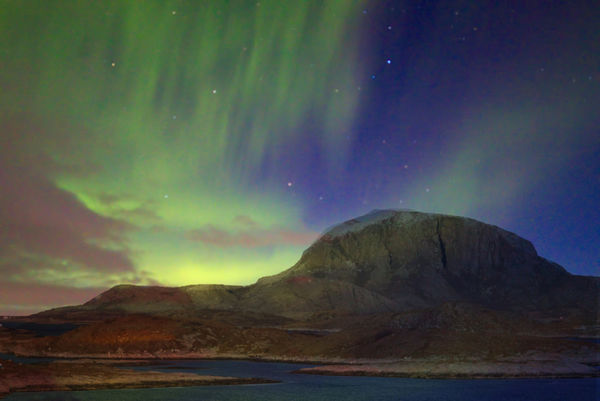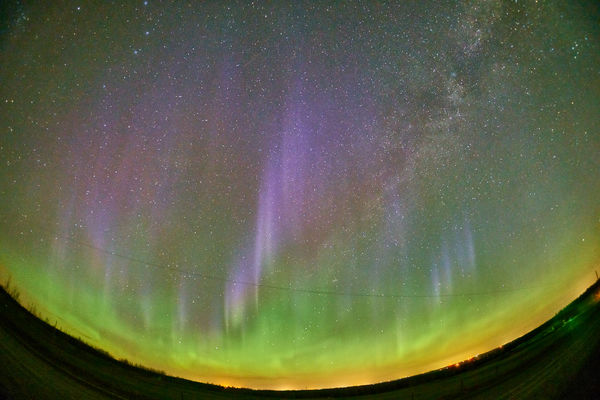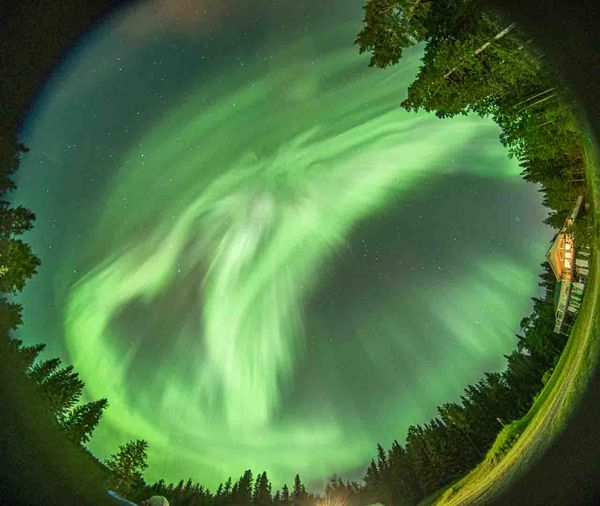Northern Lights
Dec 5, 2019 12:04:07 #
That is exactly what I hope to get. The photog's gloves are absolutely on the list, probably the camera parka, which would come in handy here in the foothills of Virginia for astro photography nights.
Dec 5, 2019 12:49:05 #
Dec 5, 2019 13:02:31 #
DougS
Loc: Central Arkansas
In case the tour company does not provide them, take some 'HOT HANDS', they are OUTSTANDING in your socks, in addition to your hands and camera. You will be glad you did!
The aurora(s) can, and do change, some faint, most are fairly stationary, but then there are those that 'dance'!
We saw one, in particular that was stationary for hours, but then, faster than a rocket can cross the sky, it began to move!!! I started with my intervalometer set to 30 seconds, quickly changed to 20, then 10, then 5, then 1, and still to slow! Wish I had switched to video... Saw 2 that really put on a big show!!!
I had no issues with condensation, and my camera was outside for 1 hour or more, at a time. But I would cover it with a coat when I came inside, in order to warm slowly, -10 to -20F.
Agree with getting part of the landscape included in the photos.
The aurora(s) can, and do change, some faint, most are fairly stationary, but then there are those that 'dance'!
We saw one, in particular that was stationary for hours, but then, faster than a rocket can cross the sky, it began to move!!! I started with my intervalometer set to 30 seconds, quickly changed to 20, then 10, then 5, then 1, and still to slow! Wish I had switched to video... Saw 2 that really put on a big show!!!
I had no issues with condensation, and my camera was outside for 1 hour or more, at a time. But I would cover it with a coat when I came inside, in order to warm slowly, -10 to -20F.
Agree with getting part of the landscape included in the photos.
Dec 5, 2019 13:09:32 #
Camera gloves with over mittens are great. Also check a hunting store for gloves/mittens for hunting, not so different from photographer - trigger and shutter both need to be activated carefully! Have a battery plan in place! Remove any filter (can make interference pattern). Practice at night shooting stars with glove/mitten on before you go. Have gaffer's tape, will travel. Time lapse video can turn out great! Hand warmers taped to the lens can help. Aim lens down when waiting for the lights to dance (prevents frost on lens). Think safety, it is night, dark, cold, strange area, etc. Wondering off for a better location, get turned around, and you may be in serious trouble. Does you camera have any bright lights (like accessing the SD Card), put gaffer's tape on them. Don't forget the date/time setting. You may have changed time zones. You may want Long Exposure Noise Reduction turned OFF. If you don't really know your camera, bring the manual. Tall tripod with ball head is usually best. Don't depend on raising the center column - it is not that stable. Be careful about changing lenses, best not to! And never change lenses on a cold camera in a warm space! If possible, scout your night photography location during the previous day. If the Aurora is static, go for longer time, lower ISO. Opposite if dynamic.
Dec 5, 2019 13:22:34 #
lightandshadowjourney wrote:
What are your thoughts on shooting the Aurora, particularly in Norway, in late February, early March with a waning Gibbous moon? I am concerned about the temp change from inside a van and out into the cold with condensation. The excursion company will provide suitable clothing and tripods. I will probably be using a Sony 65A with a Tamron 18-270, F3.5-6.3. I am curious as to taking a video if there is a probability of success with that, as well.
I regularly shoot the Aurora Borealis with a Sony A7S or A7 III with no problems in cold weather OTHER THAN some condensation when coming back into a warm vehicle / house. Keeping the lens cap on helps with the lens.
I prefer a 12-14mm lens on a full frame camera for Aurora's. I find anything longer can miss some of the action. And sometime even a 6.5mm fisheye comes close to missing a full sky Aurora's action, as seen in the 2nd attachment.
I normally shoot 10 sec. subs at about ISO 1600. I've never had much success shooting video of an Aurora; however, I have tried at high ISO's. In lieu of video I shoot time-lapses. A recent one is shown at: https://www.flickr.com/photos/brianallan/48468527346/.
Enjoy the trip!
bwa
Dec 5, 2019 13:54:41 #
Dec 5, 2019 14:26:33 #
lightandshadowjourney wrote:
What are your thoughts on shooting the Aurora, particularly in Norway, in late February, early March with a waning Gibbous moon? I am concerned about the temp change from inside a van and out into the cold with condensation. The excursion company will provide suitable clothing and tripods. I will probably be using a Sony 65A with a Tamron 18-270, F3.5-6.3. I am curious as to taking a video if there is a probability of success with that, as well.
Hello, I have captured the Northern Lights many times in Norway. It is not really that cold as you will be within the jet stream. A ziplock bag will be sufficient in preventing condensation. Leave it for at least 30 minutes before removing the battery or SD card. For video, I have always shot timelapse nd it works great. Have fun
Dec 5, 2019 14:51:37 #
lightandshadowjourney wrote:
That is exactly what I hope to get. The photog's gloves are absolutely on the list, probably the camera parka, which would come in handy here in the foothills of Virginia for astro photography nights.
What is a camera parka? I have a plastic-like "raincoat" for it.
Dec 5, 2019 14:52:56 #
hpucker99 wrote:
...People at the Geophysical Institute at the University of Alaska Fairbanks have shot videos of the auroras but they were using specialized gear. I briefly did a Google search and found several cases where the movies were made from a time-lapse sequence, not shot as video.
Good luck.
Good luck.
Have not been in Norway in February but the aurora in Fairbanks in February can get bright enough to read a newspaper by. Modern DSLRs should be able to get some useful video.
The early videos of auroral displays were made with image intensifiers, but that was back in the '60s and '70s. Things have changed since then.
Dec 5, 2019 15:17:01 #
lightandshadowjourney wrote:
What are your thoughts on shooting the Aurora, particularly in Norway, in late February, early March with a waning Gibbous moon? I am concerned about the temp change from inside a van and out into the cold with condensation. The excursion company will provide suitable clothing and tripods. I will probably be using a Sony 65A with a Tamron 18-270, F3.5-6.3. I am curious as to taking a video if there is a probability of success with that, as well.
I was in Norway on the Viking Cruise last March in Search of Northern Lights. It was the cruise we had to be evacuated from due to a loss of power in a storm near the end of the cruise. We did get to see the northern lights of which I got some pictures of. I used a Canon 70d2, with a Tamron 16-300, and a Canon 10-24 lenses. I had no problems with condensation, but I made sure I packed everything in the camera bag outside before returning inside. I took still pictures, no video. To my knowledge nobody took video on the trip, mainly because the auroras were not "dancing" while we were there. A tripod is mandatory. As for clothing, I used my skiing clothes so I had no problem. Other people dressed in numerous layers. The main thing is HAVE PATIENCE! You can be waiting for quite a while before Auroras appears, and even then it might be for a short time, or if you are lucking a "considerable" time. Good luck....Johneb

Dec 5, 2019 15:28:01 #
rtryan wrote:
Great photos and timelapse. Alberta sure closer than Baffin Island Thanks for share
And in my front yard... Definitely closer!
bwa
Dec 5, 2019 15:31:01 #
Warm air holds (evaporated) moisture much more than cold air. Sub-zero air is essentially dry. (It's all been turned to frost or snow.) The van will be heating air from outside, containing NO moisture except for that emanating from human breathers. Basically, I'm saying you won't have a problem with condensation in that environment because there won't be any moisture to condense.
Dec 5, 2019 20:06:28 #
I have been in van/bus in cold climates and if they put hot air on re-circulation, it can get humid inside and you will see condensation on the windows. Hopefully that will not be your case, but be prepared.
I have seen "chase the lights" tours advertised. The lights are about 100 miles above ground level. So if you drive for 2 hours in winter conditions, you may have only moved 70 miles or less. I question the wisdom of chasing the lights. Plan for a good open spot, and maybe have some scenery to include in the pictures.
I have seen "chase the lights" tours advertised. The lights are about 100 miles above ground level. So if you drive for 2 hours in winter conditions, you may have only moved 70 miles or less. I question the wisdom of chasing the lights. Plan for a good open spot, and maybe have some scenery to include in the pictures.
Dec 5, 2019 20:14:22 #
ralfstinson wrote:
I have been in van/bus in cold climates and if they put hot air on re-circulation, it can get humid inside and you will see condensation on the windows. Hopefully that will not be your case, but be prepared.
You are right, ralfstinson, but that's because recirculated air in an occupied vehicle will quickly become increasingly humid as long as the occupants continue breathing.
Dec 5, 2019 20:46:48 #
Just a side note here, be aware that even though you will be at far norther latitudes, you won’t have any auroras if there hasn’t been any sunspot activity that generates the formation of the aurora borealis.
If you want to reply, then register here. Registration is free and your account is created instantly, so you can post right away.





